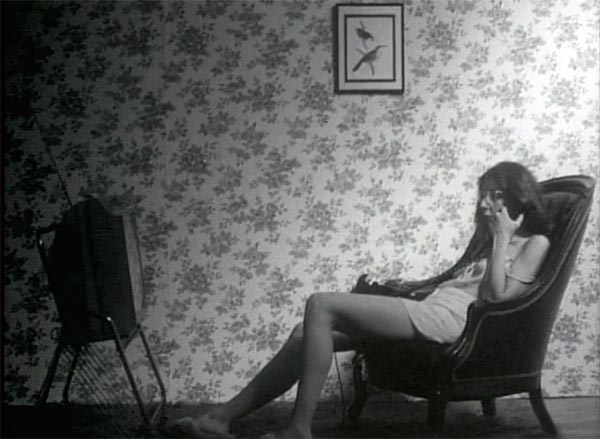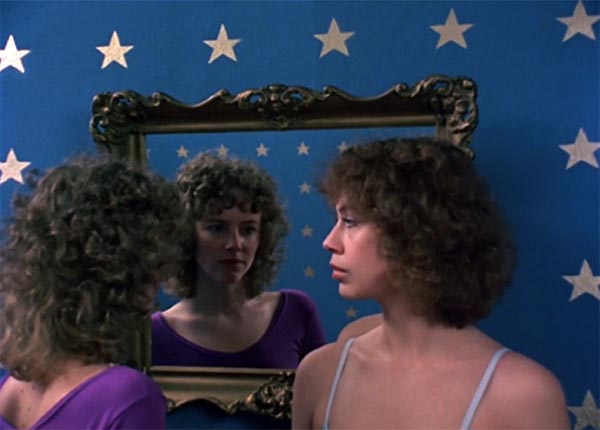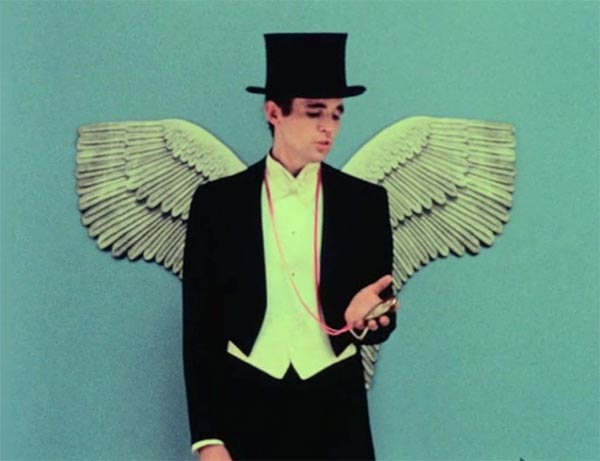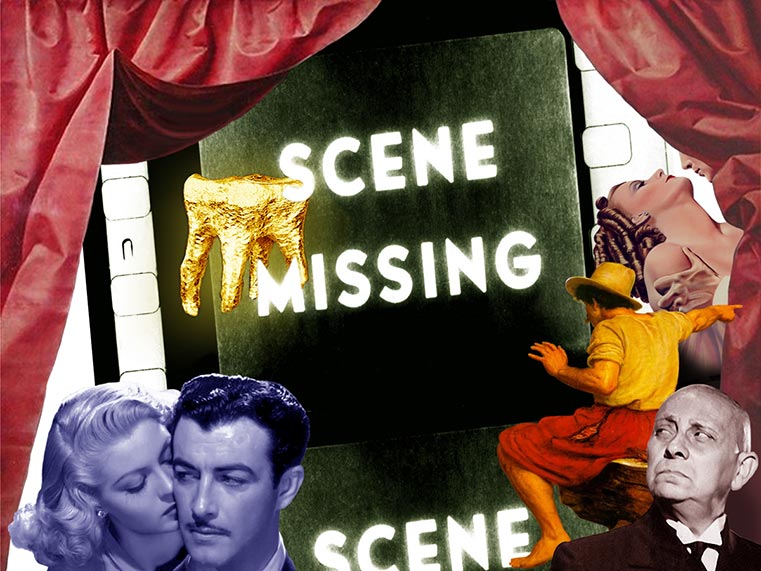Photomontage by Mark Rappaport, courtesy of the artist
Mark Rappaport once said of the late playwright Charles Ludlam that he "was not camp. He was classical." It's a quip that could easily be turned back on Rappaport himself. For the bulk of the '70s and '80s, the New York filmmaker worked steadily on micro-budget emotion pictures, carving out an immaculate dreamspace between downtown theater, structural film, genre parody, and the latter-day films of Chantal Akerman, Rainer Werner Fassbinder, and Yvonne Rainer. If Rappaport's films are ironic or affected, it's because they mine the droll glow of television sitcoms and classic Hollywood for cosmic content. Star-crossed love, frustrated desire, betrayal, fate, passion—it's the stuff of eternal art, and it's the stuff they put on TV to keep us tuned in for the ads.
Rappaport has been credited as a forerunner of the modern video essay due to his dual '90s faux-biographical features Rock Hudson's Home Videos and From the Journals of Jean Seberg. But his earlier narratives reveal him to be a pioneer of another sort: they're a glimpse into an alternate set of possibilities for the development of independent film, the eerily fully formed American response to Euro arthouse that never was.
For the next two months, Rappaport's narratives screen at Spectacle in two batches. The first, this September, includes Casual Relations, Local Color, and Mozart in Love; through October, it's The Scenic Route, Impostors, and Chain Letters. On the occasion, Screen Slate traded e-mails with Rappaport, presumably at his Paris apartment.
——
TM: Could you describe how you came to filmmaking?
MR: Well, I dropped out of graduate school after about a week and I had to find something to do—to pay the rent and stay alive. I had left college earlier and, during that time, worked as a film editing assistant. So it wasn't as if I was starting from the ground up. After about a year and a half, working in the industry, I wanted to make my own films.
TM: Which film venue or venues contributed most to your cinematic education?
I would have to say it was Million Dollar Movie on Channel 9 in New York. They would show the same movie every night. Sometimes even twice a day. You'd see great stuff as well as junk—Notorious and Miracle of the Bells, King Kong and Mr. Blandings Builds His Dream House, Citizen Kane and The Bachelor and the Bobby Soxer. Now that I think of it, of course, I don't know how I had the run of the TV all to myself. But I think it all started for real when I was 13 and saw Rashomon, which coincidentally, I'm in the middle of watching right now. It doesn't shine quite as brightly. It's unquestionably the work of a master but in every version of the story the Bitch Did It. Phooey! Anyway, after seeing Rashomon for the first time, I was hooked. That was my official crush on movies.

TM: I read that you worked for Radley Metzger for a time. How did that happen, and what was that like?
Yeah, I worked for Radley. For about ten months. I can truthfully say that after ten months, I was ready to go back to college. He was quite a character. Sort of pretentious. Funny ha ha as well as funny peculiar. Lots of anecdotes. Maybe I'll save them for my memoirs. But I did cut the trailers for Jules and Jim and Through a Glass Darkly. I'd love to see them just for a trip down memory lane. But I can't find them anywhere.
OK, here are two L'Avventura anecdotes—after seeing the film which was about 2 hours and 20 minutes, Radley offered, on his own steam, to Cy Harvey, the distributor to cut the movie down to a little under 2 hours. The distributor said, "No." That was a close call! When the trailer, which Radley cut, was sent to some theater in the Southwest, the theater owner told him it was the best trailer he'd ever seen, much better than the movie!
When I saw L'Avventura for the first time at a screening before the film opened, I think I was bathed in a cold sweat when the lights went on. I felt it was a life-changing movie for me. Now not so much.
TM: Your early films were almost entirely self-financed and filmed in your SoHo loft. I imagine that some of the particulars of that are not very interesting to talk about—as dramatized in your payment deferral phone call in Mark Rappaport: The TV Spin-Off—but I wonder if there are any tales of low-budget filmmaking that you'd like to tell. How did you hustle to get your films seen in the early days? How did you get the German television funding for The Scenic Route?
Casual Relations must have cost about $7,000. I got a grant of $20,000 to make Mozart in Love, plus another couple of thousand from a sale of Casual Relations to German TV. Local Color, too, cost in the neighborhood of $30,000. Everyone got paid $25 a day. Try that today and see how far that gets you. The budget for The Scenic Route was $35,000 flat. But lots of people came forward to help me, would let me use their cutting rooms, for example. Someone whom I was working for (to pay the rent, to pay off the debts) was so pleased and proud when The Scenic Route was invited to Cannes, he let me use his company's account so that I could get a free mix! Tell me that that can happen today! I sincerely doubt it.
As for hustling, I was never very good at that. I'm not a Zen philosopher, but whatever happened happened. Sometimes I think I was very lucky. Other times I think what a long hard row I had to hoe. With precious little help from anyone. All things considered, I guess I was very lucky. I just wish I felt that way more often.
German funding for The Scenic Route—after I finished Mozart in Love, I went schlepping around Germany with a print under my arms, going to various TV stations and one of them, ZDF, was open for suggestions of films that I might be interested in making. Et viola! They also gave me financing for Impostors, although I had to get more money elsewhere.
TM: One thing that fascinates me about the '70s/'80s in New York is that it seemed like an incredibly open moment for work that blurred or lived in between disciplinary boundaries. Your films include a number of contributions from people from outside the film world. I'm thinking of roles from video artist Peter Campus in Casual Relations; playwright Charles Ludlam in Imposters; or The Wooster Group's Ron Vawter in Postcards, and Ellen McElduff from Mabou Mines in your later narratives. I wonder if you could tell me about the cultural climate in New York at the time and your proximity to dance, theatre, or gallery art circles.
Peter was a friend, even before he started doing video work. I saw Charles Ludlam in his production of Camille and I said to myself, I have to work with this guy. I wrote the script with him in mind and then I just called him up. I don't know how I knew the Wooster Group people, but I did. I asked Ellen to audition for me. I don't know. I saw this documentary about the blank generation (editor's note: presumably Blank City) and everyone's talking about painters making films, filmmakers making music, musicians painting etc. Everybody doing everything. As if it was some goddamned Golden Age. It didn't feel like no Golden Age to me. Maybe I'm just cranky. I'm the guy in the L'il Abner cartoon with a rain cloud wrapped around his head. I was always in debt, using money from one film to pay off another, taking film editing jobs to pay off debts. Of course, now looking back on it, it does seem like a lot was going on. When you're in the Age of Lead (like now), there's no mistaking it for anything else. But if you're in a so-called Golden Age, somebody's got to remind you of it constantly.
In a sense you're right—there was a lot going on: the Wooster Group, Mabou Mines, Richard Foreman, The Ridiculous Theatrical Company, Squat Theater... And there were a million dance performances downtown. I don't know. You just feel that it's your life (and it is). And there's nothing else to compare it to. But you don't think of it as especially extraordinary. When it's gone, you see it in the rear view mirror and then you can sit shiva. When it's there, you wind up taking it for granted, as things ought to be.

TM: On the other side of the coin, New York filmmakers Milton Moses Ginsberg, Eric Mitchell, and Claudia Weill appear in The Scenic Route (which shares cinematographer Fred Murphy with Weill's Girlfriends, released the same year). Is this an indication of a community of independent filmmakers, or would that be misleading?
Well, I did know these people (as well as tons of others). Milton was the only one who already had a reputation. I loved Coming Apart when it first came out. Eric had been in a couple of films but had not made any films of his own. Claudia, after seeing Local Color, asked me if she could be in a film of mine, but this was way before Girlfriends was finished. And Fred (the greatest!!!) shot Local Color for me way before Girlfriends was finished. I don't know if there was a community or not. You knew people and it was easy enough to meet their friends. You went to the same parties, you went to the same screenings, you worked in the same film buildings.
TM: I've heard your films described as "lots of plot, no story," in reference to the unique combination of high melodrama and dream-like anti-climax.
Your first feature, Casual Relations, is a great example of this, moving between silent film, faux nudie-cuties, dream sequences, vampire pictures. It's interesting to think about it being made during what was in retrospect the height of American structural filmmaking. Your work almost seem to have the opposite impulse: hyper-narrative, an overabundance of texts. Did you think of your films as responses to the avant-garde of the day?
Although I was heavily influenced by minimalist art (look, we're all creatures of the times we live in and the current state of the arts is the one you're going respond to the most), I always preferred art that was "too much.' Like Hollywood movies, like Victorian novels. I liked art (and entertainment) that was packed to the brim—like The Bad and the Beautiful, Sunset Boulevard, Strangers on a Train, Children of Paradise, 8 1/2.
TM: Casual Relations has elements that remind me of Michael Snow's Wavelength. Any connection there?
Yes, I saw Wavelength and it was a very important movie for me. Not that I ever want to or need to see it again. But at the time, it made a great impression on me. But I also knew that my interests lay elsewhere.
TM: I wanted to ask about the music in your films. Your use of "Under My Thumb" in Casual Relations and "Doctor Love" in The Scenic Route are forever imprinted in my mind as exemplars of pop music on screen. And then there's Mozart in Love, which includes lengthy re-stagings of his arias—maybe a sneaky way to get art people to listen to pay attention to opera. Did you have musical training? Did you frequent the opera and nightclubs? Were there films that particularly guided your on-screen musical sensibility?
Unfortunately, I don't have any musical training and I've practically stopped listening to music (has a good deal to do with how my current apartment is laid out). I used to go to the opera a lot. No longer. The most influential film was seeing Visconti's Senso at a repertory theater in Chelsea. Some enterprising exhibitor dug up a print and showed it for the first time in the early 70s. I saw the film five times during its short run. The opera, the colors, the melodrama, the extravagance of the whole thing—it just swept me away. Still does. The music in The Scenic Route is the same Bruckner symphony that is used in Senso.

TM: I read Ron Vawter describe the beginnings of Roy Cohn/Jack Smith, andhe mentioned that you were working on a screenplay about the life of Cohn in the early '90s that didn't work out. Are there other ideas that didn't make it out the gate? What made you shift away from narrative films?
I had started a script about Roy Cohn, specifically for Ron. But because he was sick, he wanted to do it as a theater piece, which meant it could be done right now, and which I wasn't interested in at all. The Roy Cohn/Jack Smith aspect of it didn't resonate with me on any level. Then I felt, with Ron's theater piece, a TV movie about Roy Cohn with James Woods, and Roy Cohn appearing as major character in Angels in America—all within a very short time frame—that the Roy Cohn market was glutted. I started moving it around again in the late 90s. Michael Imperioli (brilliant!), before The Sopranos, wanted to play Cohn but I couldn't get anything to happen. Yes, there were other scripts, too. My last script (late 90s) was about the death of Pasolini. Willem Dafoe was interested in playing him, but again, couldn't get to first base. Or do I mean second base? Willem was first base. Still and all, couldn't get anybody interested in it. Too dark, too dirty. When I read that Willem was going to do a film about Pasolini with Abel Ferrara, I almost threw up. But, fortunately, it had nothing to do with my scenario.
So, after that, my Pasolini film, which I thought was my best script, I ripped up my card as an "indie" filmmaker. ("Indie" from what, I'd like to know?) I pursue other interests—like writing, making photomontages on Photoshop. And then back again making films/videos starting in 2014.
Final question: I liked your review of Snowpiercer. I was wondering if there's any other recent popular cinema that you've thought was noteworthy or exciting.
I loved Lynne Ramsey's You Were Never Really Here (editor's note: read his review here). Bertrand Bonnello's Nocturama I thought was an amazing movie as were his earlier films Saint-Laurent and Apollonide. Usually, I'm very bad at this stuff. I always seem to remember much later, after the interview, films that I really liked. Saw Chicago on Blu-ray a couple of nights ago. Think it's sensational! And saw Michael Mann's Heat in a 4K version a few weeks ago—great, as always.



